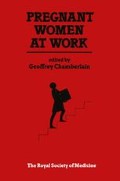Abstract
The involvement of trade unions in reproductive health is relatively new. A number of factors are involved.
Preview
Unable to display preview. Download preview PDF.
References
TUC (1980). Women Workers: 1980, A report of the TUC Women’s Advisory Committee 1979–80 and report of the 50th TUC Women’s Conference March 1980, TUC, London
Equal Opportunities Commission (1979). Health and Safety Legislation: Should we Distinguish between Men and Women?, Equal Opportunities Commission, London
Chenier, N. M. (1982). Reproductive hazards at work, Canadian Advisory Council on the Status of Women, Ottawa
House of Commons Social Services Committee (1980). Second Report: Perinatal and Neonatal Mortality, Vol. 1, HMSO, London
TUC (1981). Women’s Health at Risk, TUC, London
TUC (1982). Collective Bargaining Agreements: Assistance for Working Parents, Policy document available from the TUC on request
McKechnie, S. (1981). Reproductive hazards in employment. ASTMS Medical World, June Sullivan, F. (1981). Work and sex. ASTMS Medical World, September/ October Barlow, S. (1981). Work and sex. ASTMS Medical World, November/ December Papers presented at GMBATU/ASTMS Seminar on Reproductive Hazards at Work, Guys Hospital Medical School, 30 March 1981
Council on Environmental Quality, USA (1981). Chemical Hazards to Reproduction
Wilson, J. G. (1973). Environment and Birth Defects, Academic Press, New York
Kalter, H. and Warkany, J. (1983). Congenital malformations: aetiological factors and their role in prevention. New Engl. J, Med., 308, 424–431, 491–497
Townsend, P. and Davidson, N. (1982). Inequalities in Health, Pelican, Harmondsworth
Hemminki, K., et al. (1980). Spontaneous abortions by occupation and social class in Finland. Int. J. Epidemiol., 9, 149–153
Office of Population Censuses and Surveys (1982). Congenital Malformations and Parents’ Occupation, OPCS Monitor MB3 82/1
Erickson, J. D., et al (1979). Parental occupation and birth defects: a preliminary report. Contrib. Epidemiol Biostat., 1, 107–117
Hemminki, K., et al. (1983). Spontaneous abortions in an industrialised community in Finland. Am. J. Publ. Hlth, 73, 32–37
Elwood, J. M. and Elwood, J. H. (1982). International variation in the prevalence at birth of anencephalus in relation to maternal factors. Int. J. Epidemiol, 11, 132–137
Barlow, S. and Sullivan, F. (1982). Reproductive Hazards of Industrial Chemicals, Academic Press, London
Hemminki, K. (1980). Occupational chemicals tested for teratogenicity. Int. Arch. Occup. Environ. Hlth, 47, 191–207
White, C. G., et al (1981). Extrapolation Models in Teratogenesis (Final Report for Experiment 281), NCTR, Jefferson, Ark.
Vanek, J. (1974). Time spent in housework. Sci. Am., 231, 116–120
McDowall, M., et al (1981). Employment during pregnancy and infant mortality. Pop. Trends, 26, 12–15
Chamberlain, G. and Garcia, J. (1983). Pregnant women at work. Lancet, 1, 228–230
Saurel, M. J. and Kaminski, M. (1983). Pregnant women at work (Letter). Lancet, i, 475
Health and Safety Commission (1980). Control of Lead at Work: Approved Code of Practice, HMSO, London
US Department of Labor Occupational Safety and Health Administration (1978). Occupational exposure to lead. Fed. Reg., 43, 52952–53014
Lacranjan, I., et al. (1975). Reproductive ability of workmen occupationally exposed to lead. Arch. Environ. Hlth, 30, 396–401.
Vaisman, A. I. (1967). Working conditions in surgery and their effect on the health of anaesthetists. Exp. Khir. Anesthesiol., 3, 44–49
Edling, C. (1980). Anaesthetic gases as an occupational hazard — a review. Scand. J. Work Environ. Hlth, 6, 85–93
Department of Health and Social Security (1976). Pollution of Operating Departments, etc., by Anaesthetic Gases, HC (76) 38, DHSS, London
Anon. (1978). Counselling on the hazards of pregnancy in operating theatre staff. Anaesthesia, 33, 96–97
Cohen, E. N., Brown, B. W., et al. (1980). Occupational disease in dentistry and chronic exposure to trace anaesthetic gases. J. Am. Dent. Assoc., 101, 21–31
Anon. (1981). Protecting the Unborn Child — A Precautionary Policy at Ciba-Geigy (Health and Safety Information Bulletin No. 66), Industrial Relations Review and Report, p. 3
Krausse, L. A. (1979). [Director of Environmental Hygiene and Toxicology, Olin Corporation]. In National Safety News, February
Page, V. (1981). Freight Hire (Tank Haulage) Ltd, Health and Safety Information Bulletin No. 62, Industrial Relations Review and Report
Women’s Occupational Health Resource Centre News, 5, No. 1, February/ March (1983)
Editor information
Editors and Affiliations
Copyright information
© 1984 The Royal Society of Medicine
About this chapter
Cite this chapter
McKechnie, S. (1984). A Trade Union View of Reproductive Health. In: Chamberlain, G. (eds) Pregnant Women at Work. Palgrave, London. https://doi.org/10.1007/978-1-349-86031-9_14
Download citation
DOI: https://doi.org/10.1007/978-1-349-86031-9_14
Publisher Name: Palgrave, London
Print ISBN: 978-0-333-37117-6
Online ISBN: 978-1-349-86031-9
eBook Packages: Palgrave Social & Cultural Studies CollectionSocial Sciences (R0)

